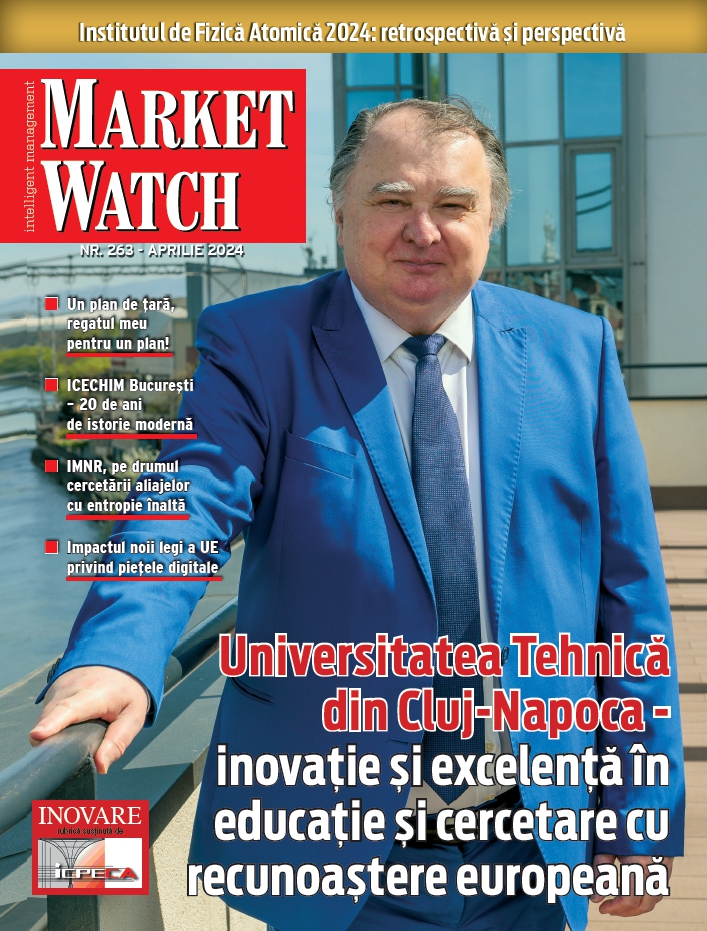ERP functionality in production processes (2)

In the previous edition we mentioned the main features of an ERP for small and medium companies with production processes. Moreover, we brought a series of concrete examples from 5-6 of the local applications. The article of the current edition will continue the subject ”ERP in the production processes, bringing into question elements of implementing a module for managing the production, the integration with other modules but also the difficulties associated with these projects.
The contemporary ERPs are becoming increasingly complex. Besides the growing number of modules, so called base, there are added features borrowed from other applications such as Document Management, CRM or BI. Thus the question of a phased implementation becomes generality and automatically induces the need to define elements (modules and features) required for each phase. In all cases, the Production module can be implemented independently of the rest of the modules wanted by the client in the ERP package.
However not all the solutions allow a stand alone implementation and the integration of this module with financial accounting applications from other sources. The option considers both the technological level of the product and the vendor strategy. Some manufacturers do not recommend it also because the achievement of the interfaces between different applications involve some additional costs and it is not always easy to achieve. As a generality, however, for the small and medium business segment, it is chosen the implementation of all modules from a single source, which is essentially the advantage of an ERP: the integration.
Boxes
" The production module Syntesio can be used in a minimal configuration, only as the stock management module, so theoretically it can work as a separate program. However, I do not recommend this because, interfacing with other systems is not easy and requires many compromises, often by turning them into weaknesses. I recommend this approach only for firms for which production is not based activity. " Cristian Dinu, Director of Development, Chara Software.
'The Production Module SAP All in One uses data such as: the classification of materials, the workstation, the technological chart, the manufacturing instructions, the lists of materials. Also there are necessary organizational structures such as: the company code, the business logistics unit, the storage place, structures that are not fully module production. Using only the module of production is not possible because there are necessary also the minimum configurations required in other modules (such as for example the definition of company code, which is a structure associated with the financial module). Mihai Chiriac, SAP All-in-One Business Consultant, EBS Romania.
Due to its modular structure, the system can be integrated into customer's existing IT structures and interfaced further with other financial management systems and by combining all modules contributes to the creation of a business performant software that can solve in the standard form the specific requirements of some economic verticals .

Robert Piukovici. Manager ERP Projects, CSB Romania.
Currently, the DataLight Production 2.0 module is not interfaced with other systems of financial management, being created a system of equivalence only with DataLight Management module 3.0. This complex system of equivalences allows to use prescription with equivalent products (raw materials), where the main ingredient is not available in stock.
.jpg)
Julian Stoicescu, General Manager Attosoft
" BcProductie Pro module can be implemented independently of other modules, where functionality is to be used strictly to production. Of course that in this case, the benefits the user may have are limited, therefore we recommend the inclusion of a management module. Thus it is possible to transfer data, essential for the running of an ERP system. We can also provide the integration with other management applications.

Bogdan Fagadar - Ghise, Chief Technology Officer, bergCOMPUTERS.
Integration with digital equipment Another important element in a ”Production” module is the integration of various digital equipment used in processes: scales, scanners, furnaces, lathes, etc.. The purpose of this integration is to takeover the data flow in real time and the transfer of it into the systems of production planning and stocks management. Also, the launching of the production orders and the recording of their completion can be made automatically. The integration with such equipments is available, upon request, in all solutions participating to the investigation, but only a few offers as standard such interfaces.
The system is open to any integration with digital systems, to the extent that this is necessary. Currently we offer interfaces for electronic scales, enabling the creation of documents for automatic output of these devices.
Julian Stoicescu, Attosoft.
For Food industry, our solution is available with a full-specific hardware solution and all control points of the enterprise (different types of scales, cells, food industry specific equipment, devices for measuring physical and chemical characteristics of raw material) are connected to the system and information is obtained in real time. Our offer includes industrial computers with stainless steel case, called CSB-Rack, for entering the data directly from the production departments. For all equipments (industrial PCs, interfaces for scales, scanners, printers) we offer both consulting and post implementation services. Robert Piukovici, CSB.
Needs for materials and the production planning One of the important functionalities of the production module is the production planning, the required materials calculation according to the orders, and matching the supply. Also, the system calculates the price based on production recipes, which is subsequently exported in the commercial modules for setting the sales prices for the products, based on the company's strategy of commercial addition, discounts to clients etc..For the production planning the system verifies complex information related to the orders placed by customers, the stocks levels, the purchase orders, the required materials in the formulation of the product, the time required for supply, production and packaging time, the available equipment, etc.. To calculate the required materials there are taken into account the smallest details of the production process according to predefined recipes, including technological losses.
Needs for materials, planning of the need, is managed in the Required Materials Planning component of the Production module, where, according to the type of planning needs, the system proposes the necessary quantities. Price calculation is performed in Product Cost Planning component which is closely related to CO module (Management Accounting). Finaly, in the production order and in the CO module (production order is also a cost object) will be seen both pre-calculation and post-calculation.

Mihai Chiriac, EBS
'Starting from the recipe for each production process it can be highlighted the needs for materials at the start of the production. Also, there can be made simulations of the necessary materials with the help of an application for Production planning. In the Production module it is made the cost calculation (both pre-calculation and post-calculation of the price / value of production). Pre-calculation has a forecast character and take account of the direct costs estimated for the price of the stock and of the direct and indirect costs in the previous month to the production month.
Post-calculation take account of actual direct and indirect costs of production months. The commercial module (bcGestiune Pro) is calculating the selling price to the customer according to company policy: price storage (production price) + commercial addition. Bogdan Fagadar - Ghisa, BergCOMPUTERS.
'Needs for materials is calculated automatically even before the start of the production, so that you can clearly predict which are the raw materials for which supply is required. Furthermore, besides displaying the current stock, it is calculated for how many days is sufficient stock of materials, for a supply on time and elimination of the delays caused by lack of materials. The price calculation is made in the same manner, taking into account the purchase prices of DataLight Management Module 3.0, even if there are unloaded several lots of input on a consumer note. Julian Stoicescu, Attosoft.
Reporting requirements The information generated in the Production module are vital to any organization. Thus, in this module are available numerous management reports. The most required reports are those of the specific consumption of raw materials and materials, the materials needed for future orders, completed orders status, pre and post-production calculation, analysis between actual and theoretical prices. Other appreciated reports are those on the quantity of raw materials and materials available and on the time when they will be found in the stock, also on the situation of working orders on the machinery, workshops or departments, analysis of quality control, etc..
Difficulties in implementation Implementation of the Production module presents the most numerous risks of failure. If the financial and accounting management for example has a high degree of standardization, the productive processes have many specific elements both at the level of economic vertical and at the company level. This situation makes the adaptation of the ERP system in the real working mode of the customer, not always to be simple. Moreover, the production processes
in many local companies are not sufficiently well organized which causes frequent changes of the ERP system configuration requirements. During implementation we face with the lack of an integrated organizational structure in the new company with resulting difficulties to accommodate the users when to switch to a centralized system. Also, the fact that the organization of production activities varies from company to company, even with the same specific of the production, requires solutions for modeling the production processes for each client, not being able to go on a standard methodology for a particular type of industry. This extended in most cases the period of implementation of the Production module. Lucian Margin, Business Consultant, Sistec
'The difficulties in implementation are induced by the lack of specialized technical staff from customers to supply the system with data on consumption workloads and operations but also by lack of linking the necessary information for this module with other modules (stock management, purchasing, sales) in the sense that information flow must be completely and covered by each user. Definition, assimilation and respect for these flows is the problem most difficult to implement, because each user must understand the implications of his work throughout the system and not only to solve his problem.

Romica Muntean, Business Consultant, Clarvision ERP, EBS Romania.
Other difficulties in implementation are related to limited technological infrastructure of the client and the impossibility of collecting real data on the production flow, leading to erroneous reporting of the consumption and hence higher production costs. To these reasons there are added others which are common to the implementation of any ERP module: the insufficient involvement of the management in the project, appointment of a project manager who does not know well the production processes, lack of motivation of people, insufficient time allocated to training, etc..

Parerea ta conteaza: 

































.jpg) Academia Română a fost creată în 1866 pentru a cristaliza cele mai înalte valori intelectuale din provinciile românești într-o societate erudită menită să consolideze identitatea națională pe baza a patru componente esențiale: limbă și literatură, istorie, etnografie și cultură. La...
Academia Română a fost creată în 1866 pentru a cristaliza cele mai înalte valori intelectuale din provinciile românești într-o societate erudită menită să consolideze identitatea națională pe baza a patru componente esențiale: limbă și literatură, istorie, etnografie și cultură. La...









 What are the best metrics in CRM?
What are the best metrics in CRM?